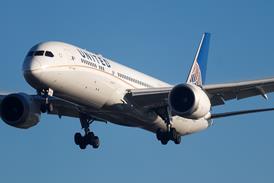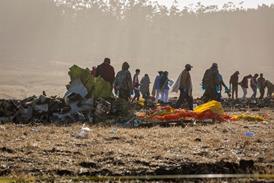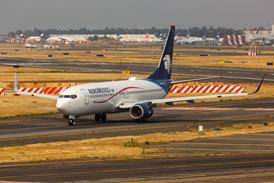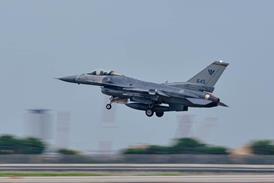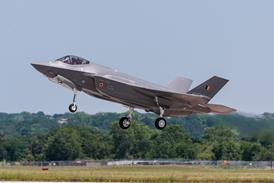Almost seven years after its liberation, Kuwait City retains an almost haunted look despite its renovation and its return as one of the major commercial centres in the Gulf. The new buildings and the traffic on its rebuilt highways are interspersed with memorials to the war dead. It is a city struggling to look forward while remembering the past. 'We will not forget them,' intone the memorials.
Rebuilding work at Kuwait International Airport centres on the new headquarters for Kuwait Airways. The airline is due to move into its new building early next year, an emotional shift after rebuilding the carrier from the mish-mash of buildings destroyed during the Iraqi invasion of 2 August 1990.
From its Cairo base in exile during the Iraqi occupation, the airline returned to a home market which had been cut in half and has since struggled financially to recapture lost market share. It has not been helped by the Kuwaiti authorities' strict visa and security restrictions and by a brand with negative connotations.
The carrier's deteriorating financial situation culminated in a net loss of US$118.3 million in the year to 30 June 1996, compared to a deficit of $94.2 million a year earlier (see chart). Sales climbed 9.7 per cent to $629.6 million and the operating loss widened from $52.2 million to $62.3 million.
Most of the blame is pinned on a 6.5 per cent fall in average yields, which dropped to 72 US cents per RTK while unit costs remained stable at 48 US cents. Overall load factor rose from 56.1 per cent to 60.3 per cent on a 9.3 per cent climb in capacity to 1.421 billion RTKs. However, while fuel costs climbed 13.4 per cent last year and finance costs from the fleet renewal cancelled out other cost savings, overstaffing and political restrictions still limit management's ability to reverse the losses. For example, general and administrative costs represented the largest single expense item at $213.8 million, 31.5 per cent of total expenses.
The national rebuilding exercise has allowed the airline's management to pressure the government to run the carrier on a more commercial basis. For the first time its fleet renewal has been built on its own credit rather than direct government purchase (albeit with state guarantees), and management is trying to move the carrier from true flag carrier status to something more like a commercial entity.
The key element of the new commercial bent is the ability to axe loss-making routes which, in the past, would have been maintained for political reasons. For example, the Kuwait-Kuala Lumpur service was cut after a six month trial despite requests from both governments to keep it going.
The strict management focus on cost control has seen expenses fall in real terms. However the reality that the airline is one of the country's few major employees of nationals prevents management from dealing with overstaffing; one source at the carrier suggests the airline could be run on around 3,000 staff compared with the 1996 total of 5,600. Officials reject this estimate as too low and are already running up against resistance in their efforts to cut numbers. A nationalisation policy has been implemented in tandem with a freeze on hiring non-nationals, but Kuwaiti technical staff have already rejected plans to cut numbers and at presstime, pilots were planning a late November work-to-rule in protest against management's attempts to change terms and conditions.
Hashim Al-Garabally, the airline's director of planning, says it is just starting to explore the possibilities of outsourcing with trial contracts for data processing in the finance and IT departments. However, political pressures still limit flexibility in this area and while maintenance and catering are two obvious areas for implementation of such a strategy, officials stress the focus will be on increasing third party work to make these departments viable rather than outsourcing.
Garabally says the airline's focus has been on a strategic reorganisation to improve systems and efficiency, including a one-year budget plan with clear goals and objectives and the development of a three-to-five-year long-term plan; revised with B777s. After across-the-board cuts in all departments the airline is concentrating on improving efficiency in its engineering, operations, human resources and IT departments. The sales force is also being restructured, reflecting a disappointing performance in the corporate and freight markets.
Alliances hold the key
With only modest network development planned over the next five years, the key factor in returning to profitability will be the Kuwait Airways' ability to build up its alliance portfolio and foster cooperation among airlines in the region. But it faces significant barriers due to its late entry in the alliance stakes and the historical reluctance of Gulf airlines to pursue cooperation.
Current alliances are limited to block seat codeshares with Cyprus Airways to Larnaca and Thai International to Bangkok, plus plans for three weekly Madras services in cooperation with Air-India. 'Alliances and airline groupings are affecting us,' says Ahmad Ibrahim Al-Hilal, the airline's marketing director. 'Frankly, we were very late to [realise] this and we are negotiating with Aaco [Arab Air Carriers' Organisation] carriers to try and reach a collective approach.' Officials cite the reluctance of some carriers to step outside their alliance groupings for route-specific deals. For example, Kuwait Airways approached SAS when it launched its Copenhagen service but the Scandinavian carrier opted to route its passengers through Lufthansa's Frankfurt-Kuwait service.
After forming a special committee to examine alliance options earlier this year, Garabally says the airline hopes to boost its network significantly through proposed codeshares with American Airlines and Ansett Australia. It plans to codeshare with the US carrier to domestic and international points beyond its New York and Chicago gateways and with Ansett to Australia through Singapore, Bangkok and Jakarta.
The one feather in Kuwait Airways' cap is the development of its relationship with Mumbai-based Jet Airways, in which it and Gulf Air each hold a 20 per cent stake. The Indian startup has emerged as the leading independent domestic carrier and provides useful feed for Kuwait Airways; 80 per cent of Kuwait's beyond gateway Indian traffic travels on Jet.
Kuwait continues to push the virtues of regional cooperation, citing the success of existing joint insurance among Gulf carriers and joint fuel purchasing at selected overseas stations. It hopes to extend the latter to other overseas carriers. However, Kuwait Airways was the only Gulf carrier to participate in a recent Aaco-sponsored study into commercial and technical cooperation conducted by SH&E. The airline argues there are significant cost savings to be made from enhanced coordination of staff training and inventory management, and has also talked with Gamco about maintenance cooperation.
Technical cooperation is more likely to emerge than coordinated commercial action. Attempts to reverse a 40 per cent fall in yields to India and the Philippines through a joint yield committee with Gulf Air and Emirates foundered after just two months. 'We are trying to bring airlines to the table to try and improve yields,' says one official. 'But we are facing problems with Gulf Air. They have not held to the agreement, but hopefully they will listen.'
After first leasing in capacity following the end of the war, Kuwait Airways has built up a fleet of three Airbus A340-300s, five A300-600Rs, three A310-300s and three A320-200s. Financial constraints have prompted the carrier to convert two Boeing 747-400s on order into two B777-200s, scheduled to arrive in February and June 1998. The carrier leases out its one remaining B767-300ER and leases in two B707 freighters from Lebanon's TMA, but no new additions are planned until 2000 at the earliest.
The carrier's network is close to its pre-invasion state with operations to 42 destinations. Europe and the US represent the largest segment in terms of traffic, accounting for 38 per cent of RPKs in 1995/96 followed by the Indian subcontinent (24 per cent), southeast Asia (16 per cent), the Middle East (13 per cent) and Gulf Cooperation Council states (9 per cent). These shares are expected to remain constant as the airline focuses on adding frequencies.
The two B777s will be used to London, Chicago, New York and Singapore-Jakarta, freeing up an A340 to operate to Bangkok and Manila. The US market is growing at 6 per cent a year and, with average load factors above 80 per cent, a third Chicago service (via Amsterdam) will be launched in the next summer schedule while an Orlando flight is also planned during the summer. Direct US services are also being considered. Aside from Madras, other new routes under consideration are twice-weekly services to Moscow, Beijing and Kathmandu, though the carrier believes sixth freedom traffic may also make a Johannesburg service viable.
Outside help
The reorganisation has been supported by Speedwing, which is providing management support in the finance and marketing departments, and by the purchase of an Airmax yield management system from Sabre Decision Technologies. The latter will be installed by the end of the year and launched on 1 February but Hilal has only modest expectations. 'We're not expecting anything in the first year and then a 1.5 per cent improvement in the second year and then we'll see what happens.' Passenger revenue is forecast to rise 6.4 per cent in 1996/7 and 36 per cent by 2000/01.
The yield management system will also allow the carrier to manage two features peculiar to the Kuwaiti market. Like other GCC markets it is highly cyclical, with 40 per cent of non-premium traffic concentrated in the summer holiday period from June to September. Second, the decision horizon for leisure traffic, particularly at the premium end, is notoriously short, with many travellers only deciding two or three days before travel. The airline plans to allocate more capacity to the O&D market at the expense of transfer business in an attempt to push up yields from this sector, charging for the lack of advance purchase. First class passengers accounted for 8.8 per cent of 1995/6 passenger revenues of $426.1 million, while business class traffic accounted for 6.7 per cent.
The seasonal bias has created an over-reliance on sixth freedom traffic through Kuwait, which accounts for more than 40 per cent of the total. While this is similar to the figure at, for example, Emirates, Kuwait has been unable to push up yields because of the country's lack of infrastructure as a true stopover destination. Leisure traffic is almost non-existent and the VFR market accounts for the balance of the airline's operations, but this is mature with only incremental growth opportunities.
The airline has sought to pressure the Kuwaiti government to start developing the infrastructure which would give Kuwait a more realistic gateway status for business traffic and also promote the country as a leisure destination. The government started to allow limited stopovers for leisure traffic in 1996. 'We have a lot of constraints and we cannot work alone,' says Hilal. 'We are trying to convince the government that we can improve the economy by bringing tourists in.' The airline has set up an outbound tour subsidiary and is studying a similar move for the inbound market.
Kuwait Airways has not been helped by the aeropolitical framework. The government launched an open skies policy last year, resulting in the carrier's share of its home market falling from 60 per cent to 52 per cent. The carrier has also been prevented from increasing fares, bar a 3 per cent rise in business class fares to London and 5 per cent to Egypt. And, not surprisingly, open skies has not been reciprocated in all markets. 'We are facing difficulties in certain areas, notably India and Saudi Arabia,' says one official. 'We could, for example, operate twice a day to Jeddah.'
The aeropolitical contradictions in a region apparently committed to open skies are symptomatic of the problems Kuwait Airways faces in trying to recapture its pre-1990 position as the largest international carrier in the Gulf. Most regimes are quite happy to allow liberalised access to international carriers, but when it comes to regional open skies the shutters go back up. Moreover, management has been charged with returning the airline to profitability without the cushion of state support evident elsewhere in the Gulf - from direct funding at Saudi Arabian Airlines to the infrastructure investment in Dubai to support Emirates.
Kuwait Airways faces a tough struggle to convince its government owners of the need for a more liberal approach to, for example, visa requirements, if it is to distribute higher yield business traffic in the region. The government has a vested interest in pursuing this path since plans to sell 20 per cent of the carrier have been shelved and will not be revived until it has recorded three straight years of profit.
However, while remaining political constraints will be lifted over time, the airline runs the risk that its policy of pursuing alliances and regional cooperation will fail to attract suitors. The Middle East airline industry is notoriously insular and executives at other carriers in the region doubt that plans for increased cooperation will bear fruit. Kuwait Airways is pursuing a worthy cause but risks falling further behind if these plans fall through.
Source: Airline Business

